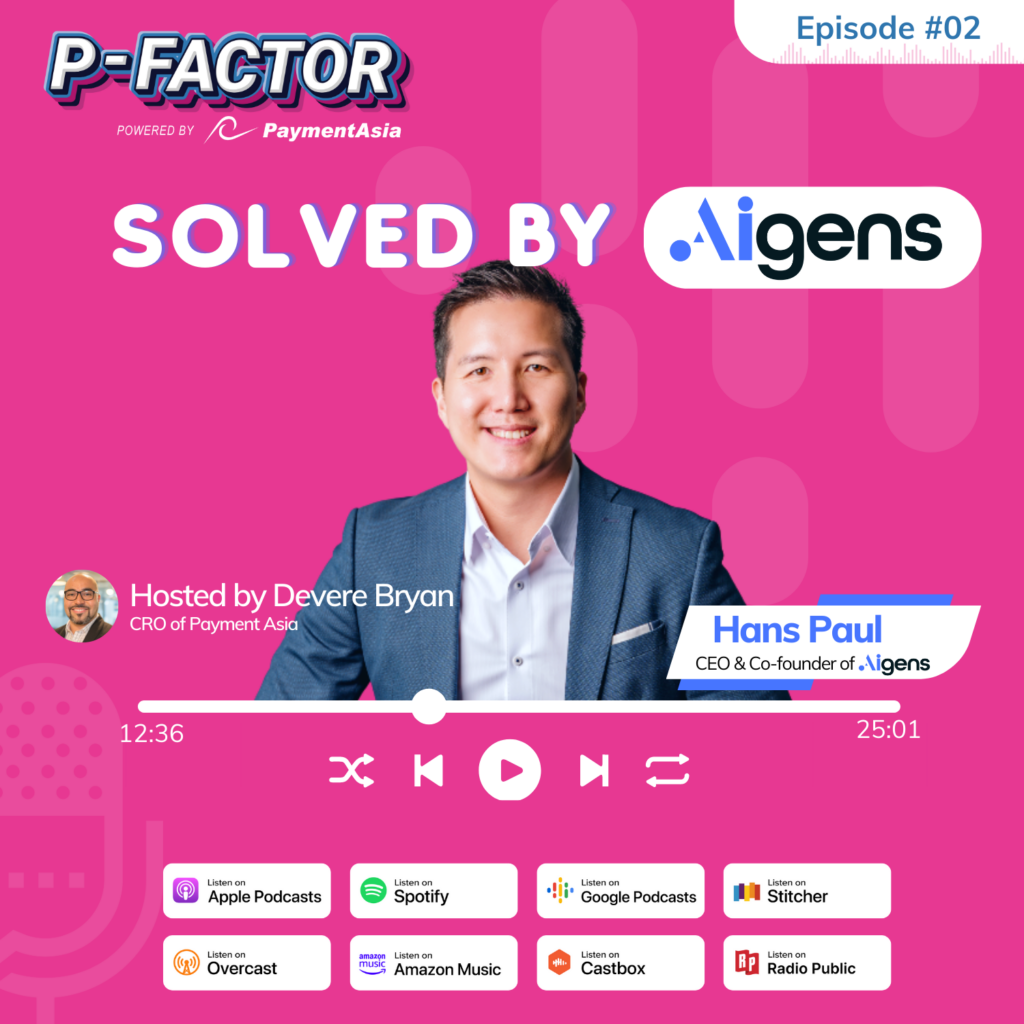Devere: Welcome to the P-FACTOR. So, today, I’ve got the great guest Hans Paul. He’s the CEO of Aigens, which is a market leading solution for digital ordering for restaurants and F&B in Hong Kong and then six other countries around the region. So, welcome very much to P-FACTOR, Hans.
Hans: Happy to be here.
Devere: Really good to have you. So tell me about you, like what brought you to this room right now but also what brought you to Hong Kong and how were Aigens born ?
Hans: Sure. Well, I’m a Hong Kong national. So I was born and grew up here until I was 16, then I move to the US. So after I graduated from UC Berkeley in Computer Science and Statistics, I was actually in the software industries for almost like 6 or 7 years in the US. My first job was actually in e-commerce, building an ecommerce solution for the enterprises. That kind of gives you a background of how we got into this space, because a lot of the solutions we built for retail at that time… We are talking about 10 years ago, which was actually very similar to what happened in the food and beverage space today, right? 10 years ago, that’s when a lot of the retailer start to form their own digital ordering solutions. They called the e-commerce website or any omni-channel solutions. And then those type of solutions also work with Amazon, the marketplace. In a way very similar to what we have in restaurants today. You have Foodpanda, as a marketplace while the restaurants also building their own in-house restaurant technology. So we are the company that helped the restaurants to build their own in-house, digital ordering solutions, that work with the different platforms out in the market.
Devere: Okay, that’s beautiful. So you are acting almost like a connector, between the merchants, the restaurant owner, or the chain, and then the supplier of the goods that are trying to buy. So how did the idea come out? This is such a part of the day-to-day ingrained way that we order food. The people are aware of, but I don’t know if they understand, A, where it started and B, actually, what a difference is between you, and as you just mentioned Foodpanda. What’s the difference between what Aigens does and what Foodpanda does?
Hans: Sure, maybe let me give you a bit of the background, how we start this idea, right? I came back to Hong Kong 201, moved back from the US for my family. And at that time my then-colleague, Peter, who actually works in the same company in the US, he one day called me up and said he got this idea. I still remember it was in a Starbucks in Kowloon Tong and then he was explaining the idea that he had. So he was telling me that “hey, imagine if we can go inside to a restaurants and be able to look on your phone and then and than this app can recommend what dishes that you should order, what is good in that restaurants and just in a few clicks you can actually finalise the payment on the phone, and the order will be sent to the kitchen”.
So now it actually makes a lot of sense. But I’m talking about back in 2011. That was still like the iPhone 2 or 3. So I think when I heard about this idea, F&B or restaurants or something are the ones we go to every day so it is relatable to my daily life. And I also strongly believed at that time, that the future is definitely going towards mobile as well as mobile payment. So I thought there’s definitely a space to be in. So that’s how we sort of started this and of course, there were a lot of challenges in the first few years but I think overall, the rations and vision stick with mobile ordering for restaurants.
Devere: It sounds to me like it’s very much part of the digital transformation that society went through. And what you’ve just described is really around communication. And, you know, for so many years, the paper was involved, right? Somebody writing down an order, somebody physically taking it and you guys have been at the vanguard of then moving that away from being physical to digital, which is the future we all want. It’s what we all live in now and it’s a future that we’re all moving towards. So it’s great to know that there’s a local Hong Kong company. That’s been instrumental in making change for SMEs. And I think one of the things that I’ve seen companies like you guys do is, become almost like an invisible aid to generate revenue for companies. Because all that stuff I talked about there with paper and people cost money, right? So if you can put some solution in place that suddenly makes things more efficient, then you see the business go. They’re able to process more people, process more orders, process everything better. And have visibility into what they’re doing.
So I’m sure that’s a big part of what you’re building towards. And I know that in the name you have AI. How do you guys utilise AI into the system and maximise the most up-to-date technology in order to facilitate this solution to the best of its ability.
Hans: So our solution essentially helps the restaurants to streamline the orders, right? And another fellow proposition is, as the diners place an order through the digital platform, there are great opportunities using AI. We can recommend dishes that are more fit for the diner’s preferences and also help the restaurants understand who the diners are. So, for example, now when you place an order on the mobile phone, we will be able to, based on your past ordering preferences, pair you with a certain dishes and then provide you recommendations in a way very similar to when you open YouTube or Netflix knowing your preferences, then the right movies are recommended to you. So very similar to food ordering, pairing with the right dishes, knowing you, whether you are allergic to certain dishes, whether you’re a meat lover … and then that will also pair with what kind of dishes the restaurants want to promote. So, the AI can also even cross data with real-time data, like weather. Let’s say, now due to certain weather conditions, people are more likely to eat takeaway food and delivery food, and then we can do a dynamic pricing strategy. So I think there are a lot of different applications that we can use AI for.
Devere: Yeah, one of the things I think of when I listen to you talk about this, is also the other side of that, like managing stock, ordering the right amount, not having waste, which is from an ESG perspective, it’s so helpful, Right now to utilise AI in order to maximise, selling the things you know you can sell, rather than hoping you’re going to sell something that you don’t, especially in something that’s going to go-off like food or drink items. So there’s so much scope to the work that Aigens is doing. I know that the business is, from the outside, people would look at it and maybe get a little bit confused as to how it works compared to Foodpanda or compared to Deliveroo. Are you guys competitors? Are you guys partners? First of all, how do you position yourself in that world? And I would like you to describe that and secondly, how do you work with partners in order to create a seamless experience for the customer, the guests?
Hans: So we look at the markets or the restaurant technology space as a very big space. So there are different types of players in it. I think the easiest segment is who is B2B or B2C. Foodpanda, is what we call the B2C player. They have an app where they marketed it to the end consumers. We are B2B. So, we sell directly to the restaurants and we also help the restaurants to bridge different B2C platforms, including Foodpanda. So that’s a difference.
B2C platforms like Foodpanda are very important that they own the users. The Foodpanda users are always their users. So the restaurant used them differently, they used them as lead generations, the lead generation for delivery space. While for us, is a solution that the restaurant buys to manage, to build relationships with their own diners, including bridging with different platforms.
So, for example, the different user data that actually belonged to the restaurants. So that’s the fundamental difference.
Devere: Yeah, understand. What I see is, some of the work that you do is unseen or maybe people take it for granted because it’s online. It’s on the computer or the phone or something. But you guys are also one of the leading producers of the kiosks. Now, you know, you go into a large chain, you guys work with some of the biggest F&B companies in the world. And now it’s taken almost for granted. There you go into these places and push buttons and self order, like that’s a massive mental change for people because the power people felt or the security people felt in the past was around trust. And that trust would be: I’m going to go talk to this human being and tell them I want A and B and C, and that thing will come to me. When you guys developed the kiosks, I imagine there was so much work that would have gone into moving people’s habits away from going over to speak to a person to then making that person a kiosk. How do you guys develop that?
Hans: So, for the contest, right? As I mentioned, our company originally created a concept of using mobile ordering. So why is it shifting to using kiosks as we launched in the first few years?
We saw that the mobile ordering part was a little bit too early for the market, where mobile payment hasn’t picked up. Still a lot of people are using a flip phone, so we saw that kiosk is actually a good transitional technology to bridge people into the digital world, while also supporting the different physical card payment, like Octopus or
the physical plastic card, right? So, it was a good stepping stone toward using mobile phones because kiosks are big giant machines inside the stores. So, I think it also makes the consumer feel a little bit more tangible, compared to ordering directly on the smartphone, and it has a certain psychological transition to the diner as well as they see that. Now when they are waiting in line inside the restaurants, there’s a long queue in the cashier, while a few people leave the line and walk to the kiosk to start placing orders and then they can get in and out quickly. Then it really helps convert the customers into using the digital ordering solutions in this case of kiosk. So it’s a good stepping stone toward that.
Devere: Yeah, it’s amazing. Actually, you know, the food ordering business now is probably going through what the banking industry went through maybe 40 years ago, when ATMs first came out and people were used to having to physically meet the person. Now you’ve got a teller outside. I’m sure this transition was kind of similar. Okay. So you know, we talked about the ordering business which is like the front face of the business that people probably see, the most through the physical kiosks, through the online ordering, through the app. Talk to me a little bit more about the other parts of the business if you would, the middleware solution is something I’d really love to understand more. How that works. And when you’re talking about being middleware, who are you in the middle of ?
Hans: Sure. I think middleware is a very interesting term, right? I think as any technologist or software company tries to disrupt the industry, in that industry there are you know, you have the new player and the old player, right? So what it means is that in the restaurant technology world, they always have this transitional POS that they have been using for the past 20 years. And these are the machines where the restaurant has invested in. Its hardware driven, and it’s there and very costly for the restaurant to switch it on. Why are the restaurants also want to use some of the newer technology that we have, right? So I think middleware is a strategy where we instead of like saying hey, we want to replace all the different player, right? We believe in collaborations, we actually work with the existing POS player. So that’s the first part of being in the middle. So we are bridging in the technology that has been there already. And the second part is that we also saw that in the restaurant space in the software world, B2B and B2C are two different games as I mentioned earlier. And we want to stay in B2B, right? So, a lot of the restaurants, even they have their own online ordering. They would still work with different platforms like Foodpanda or Openrice, right? So the second part of the middleware is bridging in the online, the B2C platform. So I just kind of sit in the middle where we are bridging the legacy software, as well as the new software, like the big birds, where is more B2C oriented.
Devere: Okay. So that’s where you kind of like a synchronizer, again in the financial industry, financial services industry. Do you have aggregators?
Hans: Yeah I think aggregators or channel managers? Channel manager is actually a more suitable word because in the end that different channels that the restaurants try to create lead generation relationships with. And there’s a lot of data flow, right? So we become a software that helps the restaurant to manage all this channel at the same time.
Devere: Beautiful, It’s as good as a holistic solution. Okay. and then the other part of the business that I’m aware of, is the loyalty and marketing press. So that then seems like it would be a perfect flow with what you’ve just talked about. How does that work for companies from the industries?
Hans: So essentially, our solution, helps the restaurant to create relationships with their diners as they use the digital ordering solutions, right? So the loyalty or the marketing technology, it helped the restaurants to understand who their diners are and then be able to create like promotions or any targeted messages that can bring them back, right? So traditionally the restaurants used paper-based coupons that are very difficult to maintain and are very limited in features. So essentially as a customer places an order, you know, using our ordering solution, then we will be able to help the restaurants to wish out and engage with the diners again.
Devere: Yeah, that’s great. And it creates stickiness. But, you know, when I listen to you talk, it’s also like a beautiful full circle. Because it goes back into what we were saying at the beginning around data, understanding the customer journey, the customer behaviours and others. So they benefit from learning about their clients or customers and then they can operate that business better because of the data they learn from those people, which is wonderful. Okay, little change of angle here. Over the last three years. The world has gone through a traumatic time with Covid-19 obviously impacted every country in the world, pretty much, I think. How did it impact your business? What changes did you see and how did it help you move your strategy over the last three years and what you’re looking to do over the next three years?
Hans: Yeah I think Covid definitely changed the entire restaurant industry upside down. Restaurants traditionally fully relied on customers dining inside the physical store, right? It’s what we call the on-premise and during Covid because there’s no dine-in. So it would really shift the ordering scenario to off-premise and then the only way you can do off-premise, is to do digital, right? So I think it definitely drastically accelerates the digitalization of the entire industry.
I guess it’s positive in terms of the entire transitions of the industries but it’s definitely tough for the industry itself, right? As the restaurants are, you know, there’s no diners and, sadly, a lot of lovely restaurants have closed down. So the silver lining is that now after all this I think, the restaurants also see that it’s very important to digitalize, right? You know, for the future. So I think from the software point of view, there’s definitely a lot of change.
Devere: Yeah. you know, it’s hard and you mentioned the term silver lining there and you know Covid-19, see a tragedy but there were positives that came from this. And I think that the digitalization of many industries was accelerated as you just mentioned because you had to evolve or you are potentially going out of business, right, evolve or die. So I saw this in a past life through people moving even their accounting from being paper-based to cloud-based because hey, how you going to go and see your account and how you’re going to get all this paper from A to B, and governments needed to digitise. You know, governments need to create apps and forms online to allow people to do things which ultimately creates more efficiency. Nobody wanted it to happen but I think that the species that were part of was good at being resilient and came up with some great solutions and again, you guys were right at the vanguard of that. I’m sure you know how to pivot a couple of times and I’m sure you get a few kiosks that didn’t get deployed. But at the end of the day, you’re thriving. Okay, so look, post-Covid are in the world right now, we are in Hong Kong. Thank goodness the event is coming back and some really cool fairs and whatnot. So, how do you guys fit into that world? Do you guys like to pop up at events and do like, you know, where people need to order food and drinks? Are you really focusing more on those steady merchants who are sitting out there with constant shopping coming through.
Hans: Yeah, so when we look at the post-Covid world for restaurants, we see that they actually become even more digitised than before, right? A lot of restaurants definitely see, now diners are going back inside the store, but it’s also very difficult to hire waiters and waitresses. So they need technology to be able to take in all that, you know, all the sales, right? And then a lot of restaurants and businesses now to make up for all the losses that have been made in the past three years, right? So part of it is also to improve the profit margin. And going back to food ordering. I mean, definitely the food delivery. People order a lot of food delivery during Covid, but that behaviour actually continues to stay. So what that means is that now the restaurants need to streamline their dine-in operations as customers are going back to the restaurants and it’s difficult for them to hire and then they still have to work with different platforms like Foodpanda. And that actually means that they need more of our solutions, right? So I think they’re definitely the digital part of it is, we will stay.
Devere: Yeah. Of course, I think that people have found that you can have a nice blend in your life between physical and digital. Well, Hans, look, we’ve reached towards the end of our time here. It’s been a pleasure while sitting with you and I realised I could have talked to you for another half an hour. I think I will possibly need to do round two at some point, my friend.
Hans: Happy to share!
Devere: Wonderful. Oh okay. Well, that’s Hans Paul from Aigens and we’re really thankful for your time today and all the best with your amazing product and your amazing company for the future.










